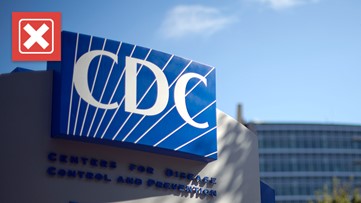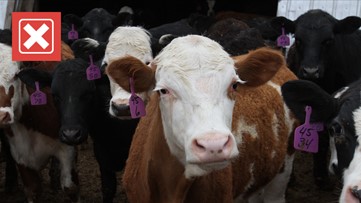Since the start of the coronavirus pandemic, SARS-CoV-2 — the virus that causes COVID-19 — has mutated multiple times. These mutations have resulted in the emergence of several variants of the coronavirus, including alpha, beta, delta, and now, omicron.
In late November 2021, the omicron variant was first detected by researchers in Botswana and South Africa. Since then, the highly transmissible variant has quickly spread across the globe, and it is now considered the most dominant variant of the coronavirus in the United States as of Feb. 7, according to the Centers for Disease Control and Prevention (CDC).
VERIFY viewer Chleo asked on Instagram if the alpha and beta variants of the coronavirus are still circulating in the U.S. despite omicron’s takeover.
THE QUESTION
Are the alpha and beta variants of the coronavirus still circulating in the United States?
THE SOURCES
- U.S. Centers for Disease Control and Prevention (CDC)
- World Health Organization (WHO)
- Global Initiative on Sharing Avian Influenza Data (GISAID), global science initiative that promotes the rapid sharing of COVID-19 data
- Nextstrain, project that provides real-time snapshots of evolving pathogen populations, such as SARS-CoV-2
- Thomas Friedrich, expert on evolution, immunity, and disease processes of pandemic viruses at University of Wisconsin-Madison
THE ANSWER
No, the alpha and beta variants of the coronavirus are not still circulating in the United States, as of Feb. 7. Current data show the omicron variant accounts for 99.9% of all cases in the country. Meanwhile, the alpha and beta variants account for 0% of all U.S. cases.
WHAT WE FOUND
The Centers for Disease Control and Prevention (CDC) use genomic surveillance to track coronavirus variants in the United States. In a process called genomic sequencing, scientists can identify which variant of SARS-CoV-2 is in a specimen collected from a portion of people who have tested positive for COVID-19. The CDC says these genomic sequences can be compared to help scientists track the spread of a virus, how it is changing and how those changes may affect public health.
In the U.S., the omicron variant currently accounts for 99.9% of COVID-19 cases in the country, while the delta variant accounts for around 0.1% of all cases, according to the CDC’s NowCast and Variant Proportions webpage. Meanwhile, other variants, like alpha and beta, have virtually disappeared in the U.S., now accounting for 0% of all COVID-19 cases as of Feb. 7, according to the CDC and the Global Initiative on Sharing Avian Influenza Data (GISAID), a global science initiative that compiles variant data from labs around the world.
A spokesperson for Nextstrain, a project that provides real-time snapshots of evolving pathogen populations, also told VERIFY in a statement that they currently aren’t detecting any alpha or beta variants in the U.S. In fact, the spokesperson says the last time the alpha or beta variants made up around 1% of U.S. sequences was between July 26 to Aug. 9, 2021, for alpha, and between May 13 to May 17, 2021, for beta, according to data collected by Nexstrain’s sister-site CoVariants.org, which also uses GISAID data.
“We do not sequence every infection so it's possible there are still a few cases of alpha and beta — but we expect this to be exceptionally low, or else it would be being caught by the very good genomic surveillance in the USA,” the Nextstrain spokesperson explained.
A weekly epidemiological update on COVID-19 published by the World Health Organization (WHO) on Feb. 1 also states that variants like alpha, beta and delta continue to decline globally due to the omicron variant. Among the 433,223 sequences uploaded to GISAID in the last 30 days, less than 0.1% of global COVID-19 cases were alpha and beta, including in countries such as Egypt, Jamaica and Belize.
On its website, the CDC explains that viruses constantly change through mutation, which can sometimes result in a new variant of the virus emerging, while others can disappear. If a new variant spreads more rapidly than existing variants, the original variants can become less predominant.
“Over the course of the pandemic, we've seen maybe three major variants come along and start to replace other ones. There was alpha, which came on the scene, maybe January of 2021, and then delta, which started to spread in the United States in late spring 2021, and then omicron, which emerged here just after Thanksgiving,” Thomas Friedrich, an expert on evolution, immunity, and disease processes of pandemic viruses at University of Wisconsin-Madison, told VERIFY.
According to Friedrich, the alpha variant never fully outcompeted the other variants of the coronavirus. When the delta variant emerged in late spring 2021, it was much more transmissible than alpha, causing a wave of delta infections in July 2021. Because it was so contagious, the delta variant overtook alpha. By late November 2021, the omicron variant, which is even more contagious than delta, was declared a variant of concern by the WHO and the CDC. Omicron quickly became the most dominant variant by the end of the year, according to the CDC.
“Omicron was fitter than delta for two reasons. One, it seems to be very transmissible — very easy to spread from one person to another, and it's very good at hiding from the immune system,” Friedrich said. “So even if you had been infected with previous variants, or if you have been vaccinated, and our vaccines are based on older variants, then the omicron variant may still infect you.”
While there is not a direct way to completely stop viruses like the coronavirus from mutating, Friedrich and the CDC say preventative measures like getting vaccinated and boosted against COVID-19, wearing high-quality masks indoors, socially distancing when possible and testing are effective ways to control the spread of the virus, which helps limit mutations.
“More people getting vaccinated means less transmission of the virus… and hopefully slower evolution. But also masking, distancing. Doing all those things that we know about further reduces the number of people who get infected and that also slows down the overall mutation rate,” Friedrich said.













